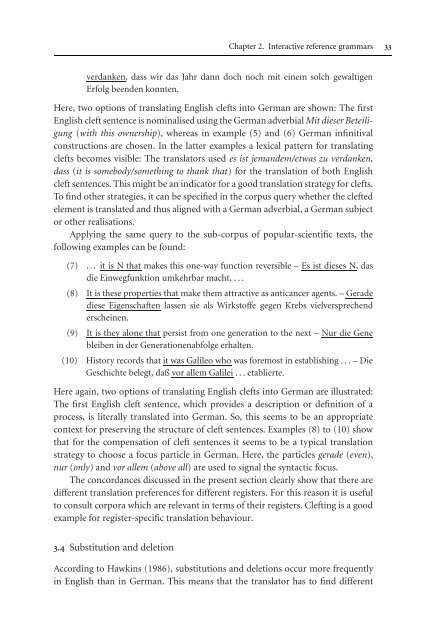Topics in Language Resources for Translation ... - ymerleksi - home
Topics in Language Resources for Translation ... - ymerleksi - home
Topics in Language Resources for Translation ... - ymerleksi - home
- No tags were found...
Create successful ePaper yourself
Turn your PDF publications into a flip-book with our unique Google optimized e-Paper software.
Chapter 2. Interactive reference grammars 33verdanken, dass wir das Jahr dann doch noch mit e<strong>in</strong>em solch gewaltigenErfolg beenden konnten.Here, two options of translat<strong>in</strong>g English clefts <strong>in</strong>to German are shown: The firstEnglish cleft sentence is nom<strong>in</strong>alised us<strong>in</strong>g the German adverbial Mit dieser Beteiligung(with this ownership), whereas <strong>in</strong> example (5) and (6) German <strong>in</strong>f<strong>in</strong>itivalconstructions are chosen. In the latter examples a lexical pattern <strong>for</strong> translat<strong>in</strong>gclefts becomes visible: The translators used es ist jemandem/etwas zu verdanken,dass (it is somebody/someth<strong>in</strong>g to thank that) <strong>for</strong> the translation of both Englishcleft sentences. This might be an <strong>in</strong>dicator <strong>for</strong> a good translation strategy <strong>for</strong> clefts.To f<strong>in</strong>d other strategies, it can be specified <strong>in</strong> the corpus query whether the cleftedelement is translated and thus aligned with a German adverbial, a German subjector other realisations.Apply<strong>in</strong>g the same query to the sub-corpus of popular-scientific texts, thefollow<strong>in</strong>g examples can be found:(7) ... it is N that makes this one-way function reversible – Es ist dieses N, dasdie E<strong>in</strong>wegfunktion umkehrbar macht, . . .(8) It is these properties that make them attractive as anticancer agents. – Geradediese Eigenschaften lassen sie als Wirkstoffe gegen Krebs vielversprechendersche<strong>in</strong>en.(9) It is they alone that persist from one generation to the next – Nur die Genebleiben <strong>in</strong> der Generationenabfolge erhalten.(10) History records that it was Galileo who was <strong>for</strong>emost <strong>in</strong> establish<strong>in</strong>g . . . – DieGeschichte belegt, daß vor allem Galilei . . . etablierte.Here aga<strong>in</strong>, two options of translat<strong>in</strong>g English clefts <strong>in</strong>to German are illustrated:The first English cleft sentence, which provides a description or def<strong>in</strong>ition of aprocess, is literally translated <strong>in</strong>to German. So, this seems to be an appropriatecontext <strong>for</strong> preserv<strong>in</strong>g the structure of cleft sentences. Examples (8) to (10) showthat <strong>for</strong> the compensation of cleft sentences it seems to be a typical translationstrategy to choose a focus particle <strong>in</strong> German. Here, the particles gerade (even),nur (only)andvor allem (above all) are used to signal the syntactic focus.The concordances discussed <strong>in</strong> the present section clearly show that there aredifferent translation preferences <strong>for</strong> different registers. For this reason it is usefulto consult corpora which are relevant <strong>in</strong> terms of their registers. Cleft<strong>in</strong>g is a goodexample <strong>for</strong> register-specific translation behaviour.3.4 Substitution and deletionAccord<strong>in</strong>g to Hawk<strong>in</strong>s (1986), substitutions and deletions occur more frequently<strong>in</strong> English than <strong>in</strong> German. This means that the translator has to f<strong>in</strong>d different
















